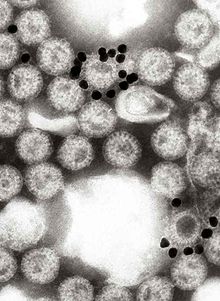
Immune electron microscopy (more often called immunoelectron microscopy) is the equivalent of immunofluorescence, but it uses electron microscopy rather than light microscopy.[1] Immunoelectron microscopy identifies and localizes a molecule of interest, specifically a protein of interest, by attaching it to a particular antibody. This bond can form before or after embedding the cells into slides. A reaction occurs between the antigen and antibody, causing this label to become visible under the microscope. Scanning electron microscopy is a viable option if the antigen is on the surface of the cell, but transmission electron microscopy may be needed to see the label if the antigen is within the cell.[2]
- ^ Lodish, Harvey; Berk, Arnold; Kaiser, Chris; Krieger, Monty; Bretscher, Anthony; Ploegh, Hidde; Amon, Angelika; Martin, Kelsey (April 1, 2016). Molecular Cell Biology (8 ed.). W.H. Freeman. ISBN 978-1464183393.
- ^ "Immuno-Electron Microscopy Services at the Core Electron Microscopy Facility - UMASS Medical School". UMass Chan Medical School. 2 November 2013. Retrieved 5 December 2022.